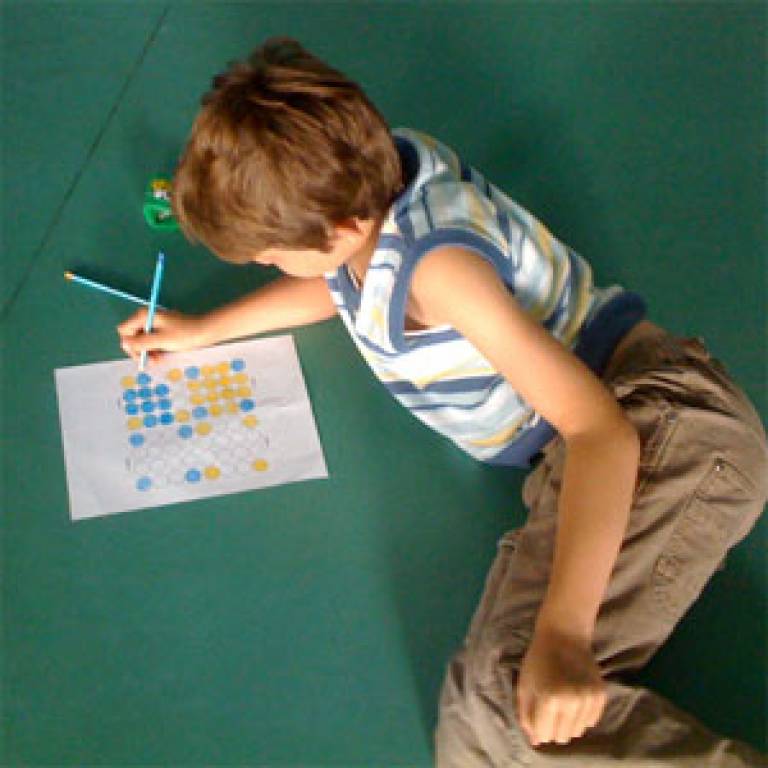Primary school children authors on science paper
22 December 2010
Links:
 org/" target="_self">Royal Society
org/" target="_self">Royal SocietyBiology Letters
A group of UK
primary school children have achieved a world first by having their school
science project accepted for publication in an internationally recognised
peer-reviewed Royal Society journal.
The paper, which reports novel findings in how bumblebees perceive colour, is published in Biology Letters today.
The research was undertaken by 8-10 year old pupils at Blackawton School in Devon, who investigated the way that bumblebees see colours and patterns. The young scientists found evidence that bees are able to learn and remember cues based on colour and pattern in a spatially complex scene. The field of insect colour and pattern vision is generally poorly understood and the findings reported by the school children represent a genuine advance in the field.
The project was coordinated and funded by Dr Beau Lotto, UCL Institute of Ophthalmology. Dr Lotto is currently developing a 'living lab' at London's Science Museum, funded by the Wellcome Trust, which enables the public, including school children, to participate, design and run real science experiments on site.
Dr Lotto said "The publication of a scientific paper entirely conceived and written by schoolchildren shows what's possible if we celebrate uncertainty. Real scientific work is full of uncertainty - that's why it's so exciting - but I find that this is what's lacking in education, where subjects are too often presented as a series of dull factual certainties. The publication of this work is an important step in showing what we can achieve if we're prepared to approach science in a way that's creative, daring and, above all, fun."
Professor Brian Charlesworth FRS, Editor of Biology Letters said: "This paper represents a world first in high quality scientific publishing and I'm proud that Biology Letters is supporting this highly innovative approach to science education. This is a unique way of encouraging children's engagement with science by getting a group to write about their work in a publishable format. I hope that it will inspire other groups to realise that science is not an exclusive club but something that's available for everybody."
As with all papers accepted for publication in Biology Letters, the paper successfully went through peer review. The presentation of the paper is unconventional because the paper contains no references due to the inaccessibility of the existing scientific literature to 8-10 year olds. However, it has been published alongside a commentary by Laurence T. Maloney of New York University's Center for Neural Science and Natalie Hempel de Ibarra of Exeter University's Centre for Research in Animal Behaviour.
In their commentary, which is fully referenced and provides background to the research, Hempel and Maloney write: "The experiments are modest in scope but cleverly and correctly designed and carried out with proper controls to avoid possible artefacts. They lack statistical analyses and any discussion of previous experimental work, but they hold their own among experiments carried out by highly-trained specialists. The experimenters have asked a scientific question and answered it well."
Images: Pupils form Blackawton School working on the project. (Copyright: Beau Lotto)
UCL context
The UCL Institute of Ophthalmology aims to develop new treatments for eye disease out of a large and varied foundation of basic research. Its researchers work very closely with Moorfields Eye Hospital NHS Foundation Trust and are part of UCL Biomedicine, one of the largest aggregates of biomedical expertise in the world.
The range of diseases studied extends from inherited retinal degenerations affecting young children to age-related macular degeneration and glaucoma, the most common causes of blindness in the elderly. Currently groups are investigating every stage of the visual process from the mechanics of rods and cones to the brain's interpretation of complex visual scenes. The institute's researchers are making progress in understanding the basic mechanisms of blinding disease and investigating new methods of treatment by conventional pharmacology, gene therapy and cellular therapy including stem cells.
Related news
Children
and adults see the world differently
Optical illusions dazzle conference
for leading thinkers
 Close
Close

